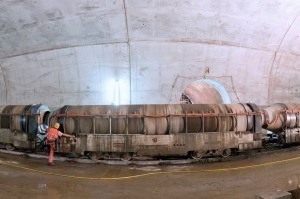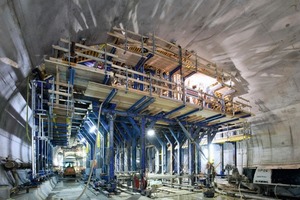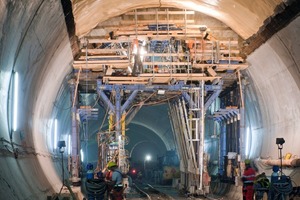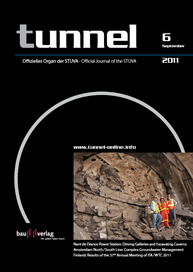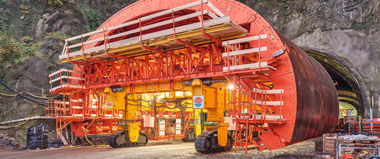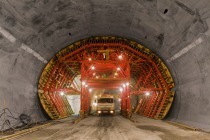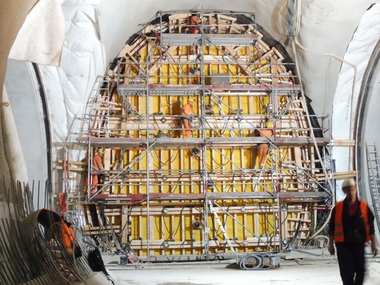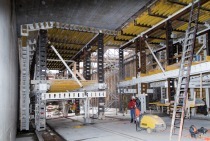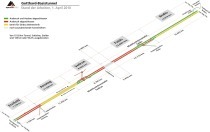Fully-hydraulic Forming for complex Tunnel Cross-Section
In the Gotthard Base Tunnel’s Erstfeld section a fully hydraulic and flexibly adjustable tunnel forming carriage served to execute the inner shell for 2 branching structures, which tapered greatly in their cross-sectional dimensions.
With a length of 57 km the twin-tube Gotthard Base Tunnel in Switzerland is the world’s longest rail tunnel. Furthermore on account of the tricky geological general conditions it also represents a pioneering performance in mining. The AlpTransit Gotthard AG commissioned the AGN JV consisting of Strabag AG Tunnelbau Schweiz and Strabag AG Spittal/Drau Österreich to produce the 2 northern contract sections Amsteg and Erstfeld with a total length of 19 km.
The 7,400 m long Erstfeld contract section is the northernmost part of the Gotthard Base Tunnel also embracing two 400 m long branching structures produced by drill+blast followed by in situ lining. The branching structure’s 2 bores are extremely complex construction sections on account of their geometry and the logistical marginal conditions. According to AGN project manager Beat Blindenbacher, Doka provides an important contribution towards this project “with technical know-how and strong support”.
Systematic Adjustment
A significant change in cross-section from 5.72 m wide and 7.92 m high in the first concreting section to 17.54 m wide and 10.10 m high in the final one characterises the 2 branching structures. As the construction operations commence with the greater cross-section the tunnel forming carriage comprising rentable system parts can be “reduced” in the altogether 37 concreting sections so that it can be adjusted to the new section. In order to comply with the client’s demand for short cycles times, straightforward forming up and stripping procedures as well as economically optimised progress in construction, the formwork specialists devised a fully hydraulic tunnel forming carriage. It is exactly geared to the project’s specific requirements and at the same time set up consisting of over 75 % system components. In this way the JV was able to arrive at extremely short cycle times.
The side walls of the branching structures are first created using Top 50 large-area formwork elements on steel trusses specially produced for this project. This construction was designed by Swiss general agent Holzco-Doka to be sufficiently slim so that it does not impede on-site rail traffic at all.
Tremendously strong and totally safe
As the name suggests, Doka’s SL-1 heavy-duty supporting system is built for heavy loads and provides the torsionally rigid bearing structure for the two-part crown-arch formwork for the tunnel roof. The starting cross-section is so wide that for the first 12 concreting sections the forming carriage uses 6 rows of propping structures set up to allow portals for the in-tunnel service rail wagons and other site traffic. The forming carriage is also CE-approved and has fully enclosed platforms at all working levels and ladders with integral cages to maximise safety for the entire crew.
The crown-arch formwork consists of Top 50 beam formwork sections and is carried by a total of 144 heavy-duty spindles. Adaptation of the formwork to the structure’s changing width has to be easy and practical, so the large-area formwork assemblies that make up the 2 halves of the crown arch retract inward section by section on powerful hydraulic rams. The superfluous formwork segments are then removed and the arched formwork is precision-closed. This soundly planned solution ensures that rapid and regular working routines can be maintained through each concreting section in turn. After concreting section No. 12 in the eastern branch and No. 14 in the western, the cross-section tapers to the extent that two rows of props have to be removed from the supporting structure and new crown-arch formwork put in place.
170 t placed at the Touch of a Button
Sixteen high-performance hydraulic rams make forming up and stripping, lowering and moving the huge forming carriage fully automatic operations with straightforward push button control. Each routine advance moves a supporting structure and formwork weighing 170-plus tonnes rapidly and accurately into position for the next concreting section. The rolling carriages designed specially for this project and built to handle the structure‘s tremendous deadweight are propelled by 4 powerful hydraulic motors. Similarly, there are twice as many hydraulic rams for lifting and lowering as would normally be carried on a forming carriage of more conventional proportions.
The 2 contract sections are about 4 kilometres in from the north portal of the Gotthard Base Tunnel and can be reached only by an in-tunnel service railway. Space is at a premium, so the load-bearing structure and the crown-arch formwork had to be transported to site section by section and assembled and set up in the extremely tight space available. „The professional support provided by the Doka site foremen significantly speeded up assembly of the carriage and ensured smooth formwork progress right from the very first concreting section on“, reports site director Erich Werner.

